Communication theory
Appearance

Communication theory is a field of information and mathematics that studies the technical process of information] and the human process of human communication.
Quotes
[edit]- The general notion in communication theory is that of information. In many cases, the flow of information corresponds to a flow of energy, e.g. if light waves emitted by some objects reach the eye or a photoelectric cell, elicit some reaction of the organism or some machinery, and thus convey information.
- Ludwig von Bertalanffy (1968) General System Theory. p. 41.
- A more viable model, one much more faithful to the kind of system that society is more and more recognized to be, is in process of developing out of, or is in keeping with, the modern systems perspective (which we use loosely here to refer to general systems research, cybernetics, information and communication theory, and related fields). Society, or the sociocultural system, is not, then, principally an equilibrium system or a homeostatic system, but what we shall simply refer to as a complex adaptive system.
- Walter F. Buckley (1968) "Society as a complex adaptive system" in: Modern systems research for the behavioral scientist. Walter Buckley ed. p. 490.
- They developed a model of communication which was intended to assist in developing a mathematical theory of communication. Shannon and Weaver's work proved valuable for communication engineers in dealing with such issues as the capacity of various communication channels in 'bits per second'. It contributed to computer science. It led to very useful work on redundancy in language. And in making 'information' 'measurable' it gave birth to the mathematical study of 'information theory'
- Daniel Chandler (1994). The Transmission Model of Communication. University of Western Australia.
- The theory of communication is partly concerned with the measurement of information content of signals, as their essential property in the establishment of communication links. But the information content of signals is not to be regarded as a commodity; it is more a property or potential of the signals, and as a concept it is closely related to the idea of selection, or discrimination. This mathematical theory first arose in telegraphy and telephony, being developed for the purpose of measuring the information content of telecommunication signals. It concerned only the signals themselves as transmitted along wires, or broadcast through the aether, and is quite abstracted from all questions of "meaning." Nor does it concern the importance, the value, or truth to any particular person. As a theory, it lies at the syntactic level of sign theory and is abstracted from the semantic and pragmatic levels. We shall argue … that, though the theory does not directly involve biological elements, it is nevertheless quite basic to the study of human communication — basic but insufficient.
- Colin Cherry (1957)On Human Communication (p. 10).
- Communication theory is enormously rich in the range of ideas that fall within its nominal scope, and new theoretical work on communication has recently been flourishing. Nevertheless, despite the ancient roots and growing profusion of theories about communication, I argue that communication theory as an identifiable field of study does not yet exist.
- Incomplete knowledge of the future, and also of the past of the transmitter from which the future might be constructed, is at the very basis of the concept of information. On the other hand, complete ignorance also precludes communication; a common language is required, that is to say an agreement between the transmitter and the receiver regarding the elements used in the communication process...
[The information of a message can] be defined as the 'minimum number of binary decisions which enable the receiver to construct the message, on the basis of the data already available to him.' These data comprise both the convention regarding the symbols and the language used, and the knowledge available at the moment when the message started. [A Summary of Communication Theory]- Dennis Gabor (1952) "Optical transmission," in: Information Theory: Papers Read at a Symposium on Information Theory. as cited in: James Grier Miller (1978) Living Systems. p. 12.
- General evolution theory, based on the integration of the relevant tenets of general system theory, cybernetics, information and communication theory, chaos theory, dynamical systems theory, and nonequilibrium thermodynamics, can convey a sound understanding of the laws and dynamics that govern the evolution of complex systems in the various realms of investigation.... The basic notions of this new discipline can be developed to give an adequate account of the dynamical evolution of human societies as well. Such an account could furnish the basis of a system of knowledge better able to orient human beings and societies in their rapidly changing milieu.
- Ervin László et al. (1993) pp. xvii- xix; as cited in: Alexander Laszlo and Stanley Krippner (1992) "Systems Theories: Their Origins, Foundations, and Development" In: J.S. Jordan (Ed.), Systems Theories and A Priori Aspects of Perception. Amsterdam: Elsevier Science, 1998. Ch. 3, pp. 47-74.
- The very essence of mass communication theory is a simple but all-embracing expression of technological determinism, since the essential features depend on what certain technologies have made possible, certain technologies have made possible, especially the following: communication at a distance, the multiplication and simultaneous distribution of diverse ‘messages’, the enormous capacity and speed of carriers, and the limitations on response. There is no escaping the implication that public communication as practised in modern societies is profoundly shaped by these general features
- Without an understanding of causality there can be no theory of communication. What passes as information theory today is not communication at all, but merely transportation.
- Marshall McLuhan (2011) The Book of Probes : Marshall McLuhan. p. 362.
See also
[edit]External links
[edit]Wikibooks has a book on the topic of


